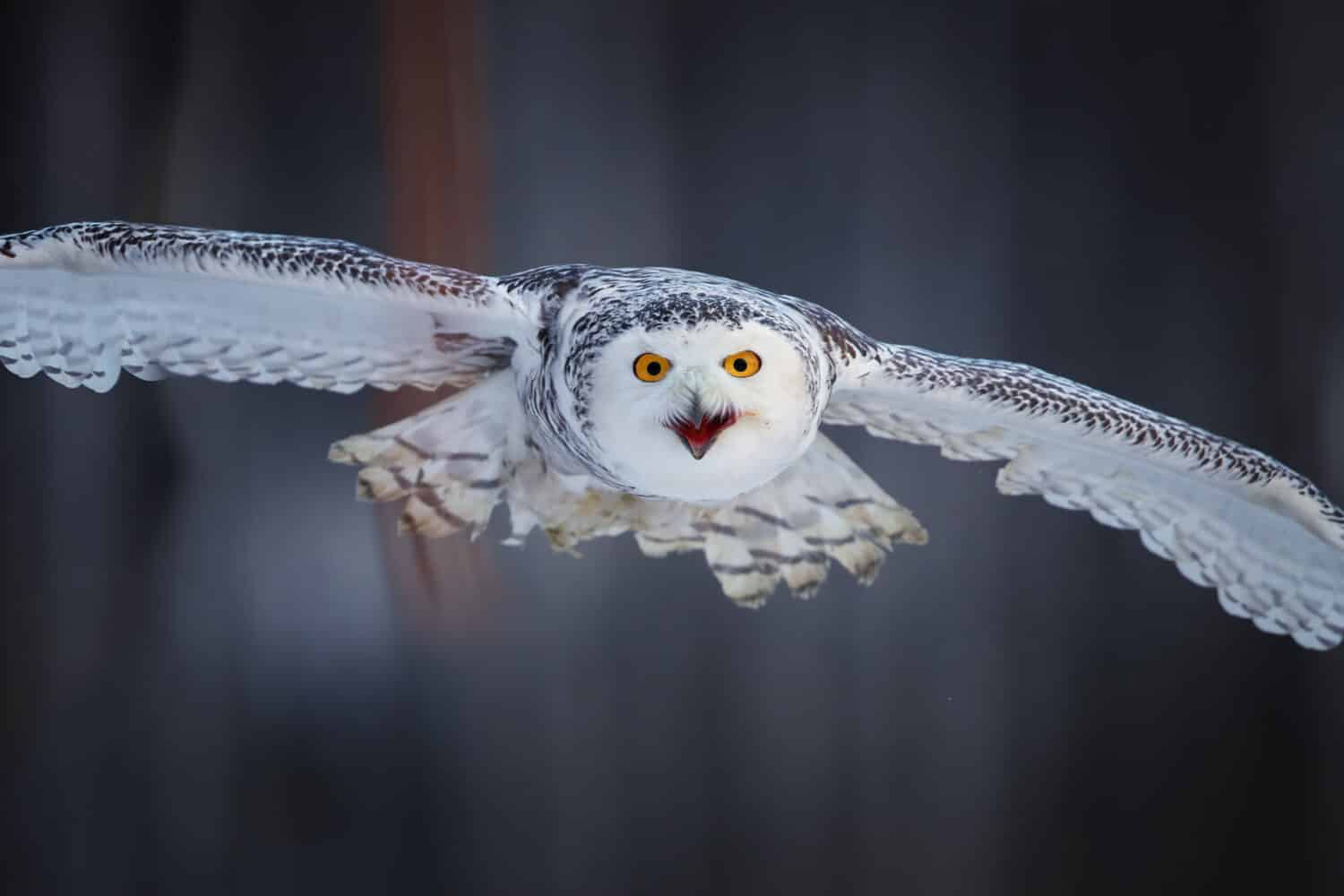In the cold months, Wisconsin is not just about football and outdoor sportsmanship. Nature is alive and well to be experienced. The state is brimming with a diverse bird population that spends their Winter there. It’s hard to pinpoint the exact amount in a state with more than 300 species of birds, but here are the most prevalent, non-migratory ones in case you’re out bird-watching in the snowy wonderland.
Black-Capped Chickadee
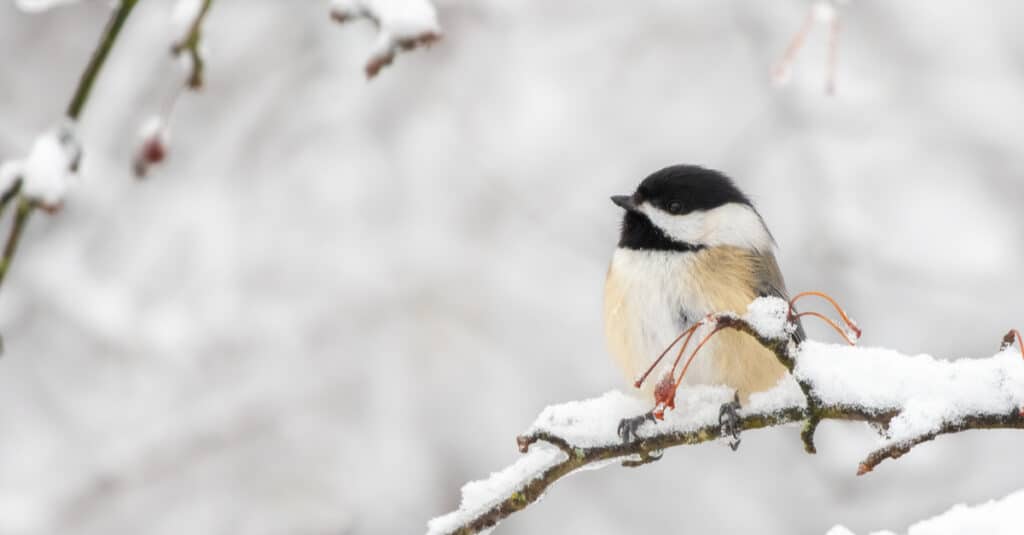
Black-Capped
Chickadee
is known for acrobatic prowess
©Mr.Coffee/Shutterstock.com
The Black-capped Chickadee is a minute bird known for its distinctive black cap and bib. Like most birds presented here, their habitat is varied: forests, woodlands, and suburban areas. Their diet consists of insects, seeds, and berries. In the freezing months, they lean on insect eggs and pupae, as well as animal fat from dead animals. A notable quality of this avian is its acrobatic prowess, and it can often be spotted hanging upside down from branches to feed.
Fun Fact: Chickadees own a complex language and remarkable memory and can remember the location of thousands of food caches.
Dark-Eyed Junco
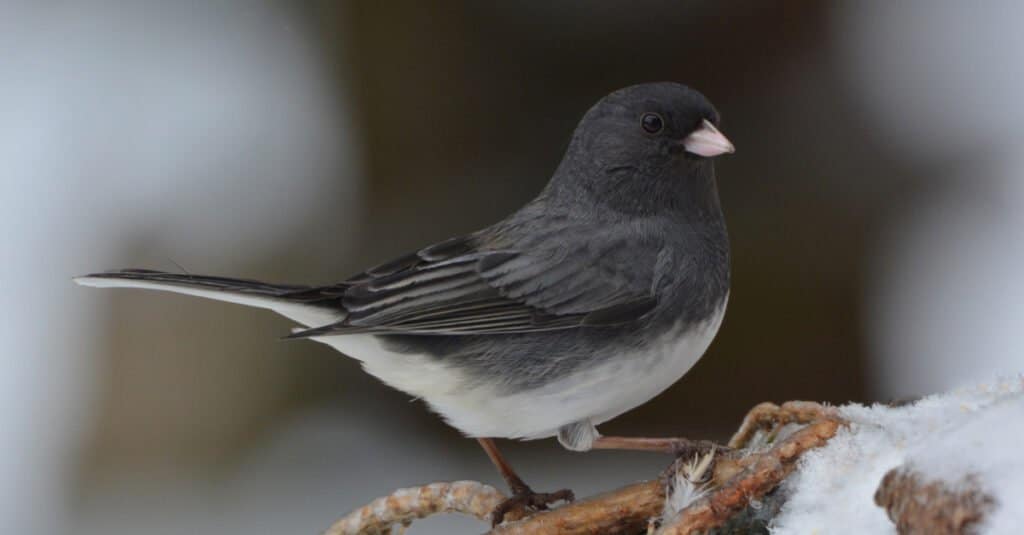
The Dark-Eyed Junco is a notoriously hierarchical species and is known as a “Snowbird.”
©C. Hamilton/Shutterstock.com
The Dark-eyed Junco is an undersized sparrow with a gray head and back and a white belly. The subspecies makes its home in forests, fields, and even human backyards. Their primary diet is seeds and insects, although they go for weed and grass seeds in the deep of Winter. They are a notoriously hierarchical species, meaning bigger birds lord over smaller ones, while older birds have authority over younger ones.
Fun Fact: Juncos are sometimes called “snowbirds,” as they are abundant during the winter months and certainly abundant even in the Arctic regions.
American Goldfinch
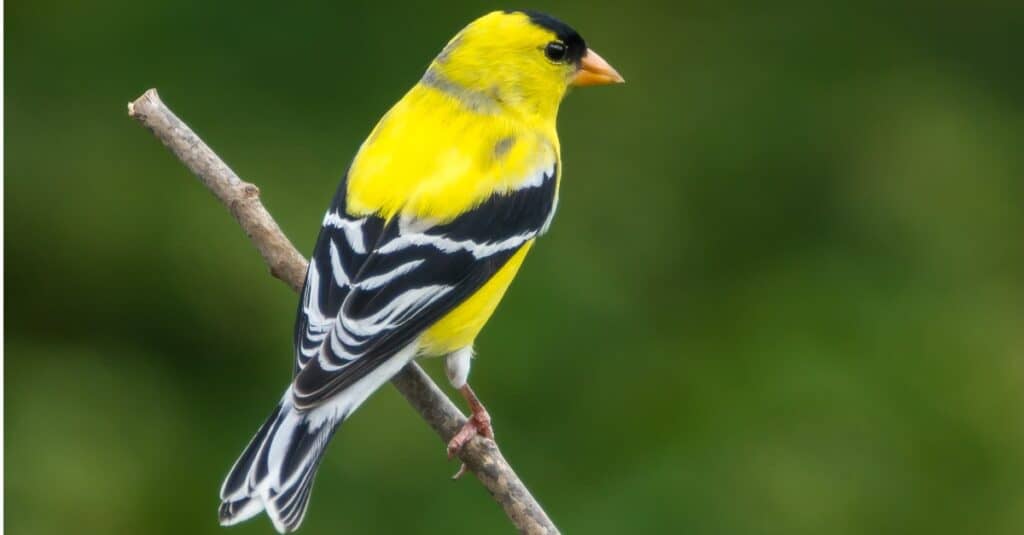
The American goldfinch is the state bird of New Jersey, Iowa, and Washington.
©iStock.com/impr2003
The American Goldfinch is yet another tiny avian. They are recognized for their bright yellow feathers and black wings – and are located in fields, meadows, and backyards. Seeds and insects make up their primary diet, though they consume thistle seeds, which they can extract using their specialized beaks.
Fun Fact: Goldfinches are the state bird of New Jersey, Iowa, and Washington.
Northern Cardinal

Males of the Northern cardinal get the bright red feathers.
©Bonnie Taylor Barry/Shutterstock.com
Like all Cardinals, the Northern Cardinal is famed for its regal look and song. You get distinctive bright red feathers and a head crest (the female, though, sports brown with red accents for plumage). Forests, woodlands, and varied suburban areas are its home, and the bird feeds on insects, fruits, and insects. Digging the hard ground for food is no problem for this species. This non-migrating bird is notorious for their territorial behavior and aggressive males that will even attack their reflection in windows or mirrors.
Fun Fact: Cardinals are legendary for their gorgeous singing, commonly heard in the early hours.
Downy Woodpecker
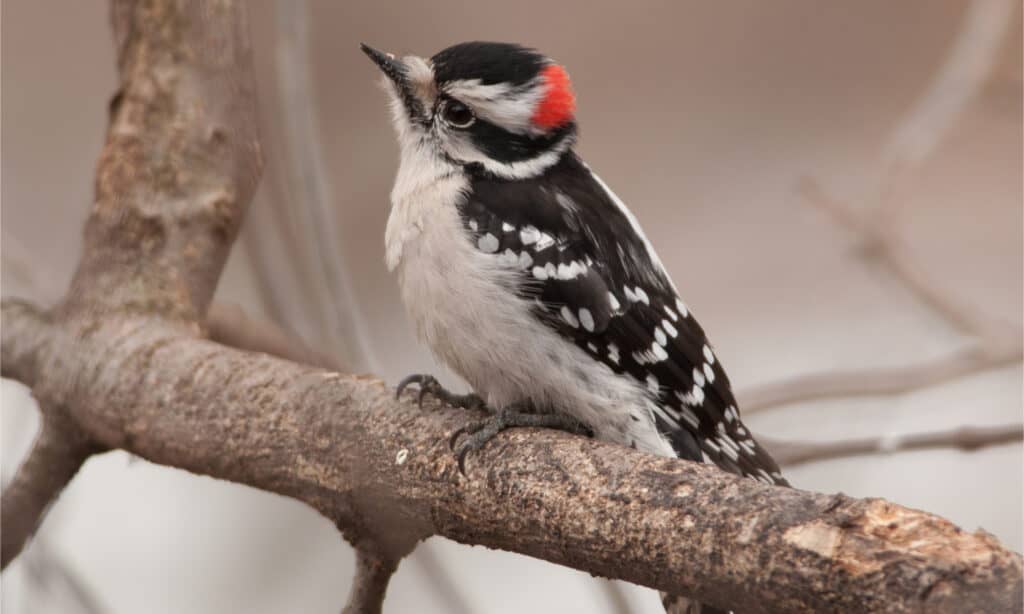
Like all woodpeckers, it’s an expert wood driller.
©Gerald A. DeBoer/Shutterstock.com
Small in stature, the Downy Woodpecker’s black and white feathers identify it – plus a distinctive red patch on the back of its head. They make their home in forests, woodlands, and suburban areas. Using their bills to drill into trees, they consume insects like moths, wasps, beetles, and an assortment of larvae.
They also employ their beaks to drum on trees to create a unique rhythmic pattern to attract mates.
Fun Fact: Downy Woodpeckers happen to be the smallest woodpecker in North America.
White-Breasted Nuthatch

The White-Breasted Nuthatch can defy gravity by walking down trees.
©Jim Nelson/Shutterstock.com
The White-breasted Nuthatch lives in Wisconsin parks, residential areas, and deciduous forests. The diminutive animal is recognizable by its blue-gray feathers and white belly. Like most of its kind, they feed on insects and seeds. The White-breasted Nuthatches possess a singular practice of using sticky sap to seal the entrance to their nests – all to prevent predators and store their insect/seed diet.
Fun Fact: Nuthatches can easily walk headfirst down trees.
American Crow
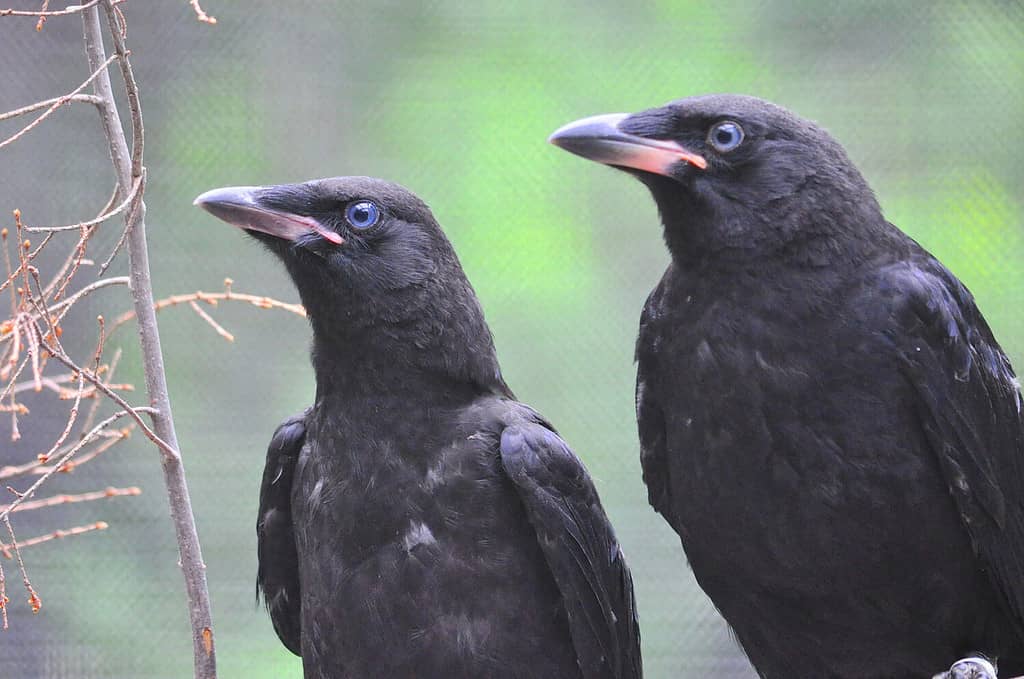
Crows are common but exceptional in their high intelligence.
©Elizabeth Caron/Shutterstock.com
Finally, there is a large bird on the Wisconsin winter bird list. Most people know this when it comes to the common American Crow. Nobody will be surprised by its black feathers and distinct caw. They thrive in almost any habitat, from fields to typical suburban neighborhoods. Their diet is similar to all birds, insects, and fruits, but it does include carrion. Amazingly, this bird species can recognize human faces, remembering individuals who have treated them kindly or negatively.
Fun Fact: Crows are highly intelligent, even spotted using tools to find food. They even drop hard-shelled nuts onto a street and wait for a passing car to crush the shell.
Blue Jay
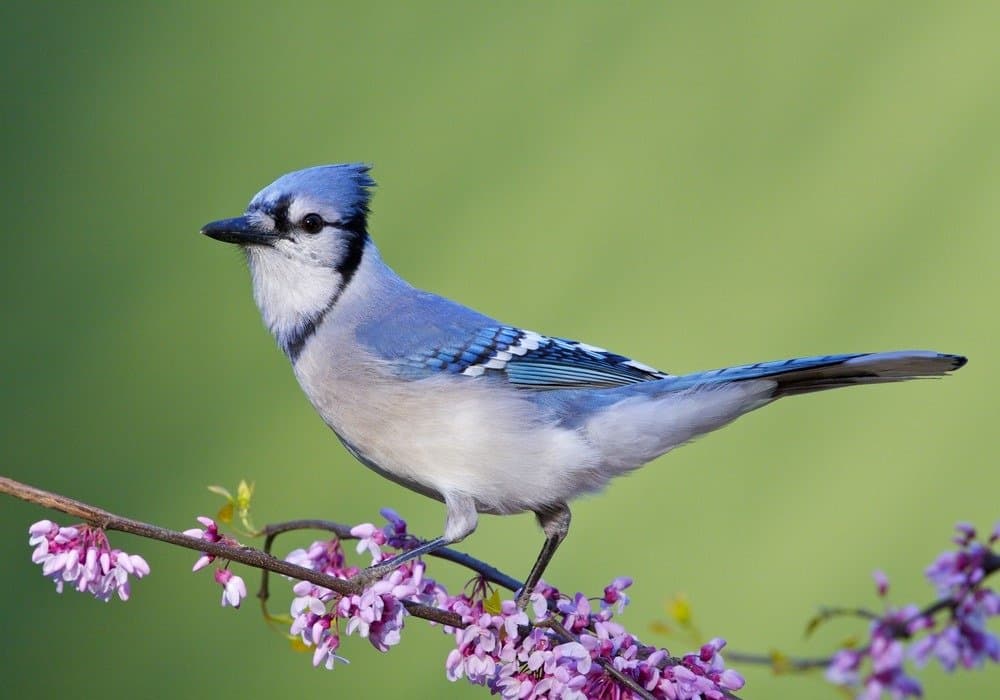
Blue Jay on Eastern Redbud, side view
©Tom Reichner/Shutterstock.com
Like the crow, the Blue Jay is a widely-known bird – rewarded with striking blue feathers and a distinctive crest on its head. And the two avians are related as they share a common ancestor! They also share the same diet and habitat as crows and many other birds, except they possess a unique habit of caching food: hiding acorns or other items in the ground or trees for later consumption. Like crows, however, they occasionally employ tools.
Fun Fact: Blue Jays can mimic sounds to keep other birds away from their territory, from cat meows to hawk screeches.
Mourning Dove
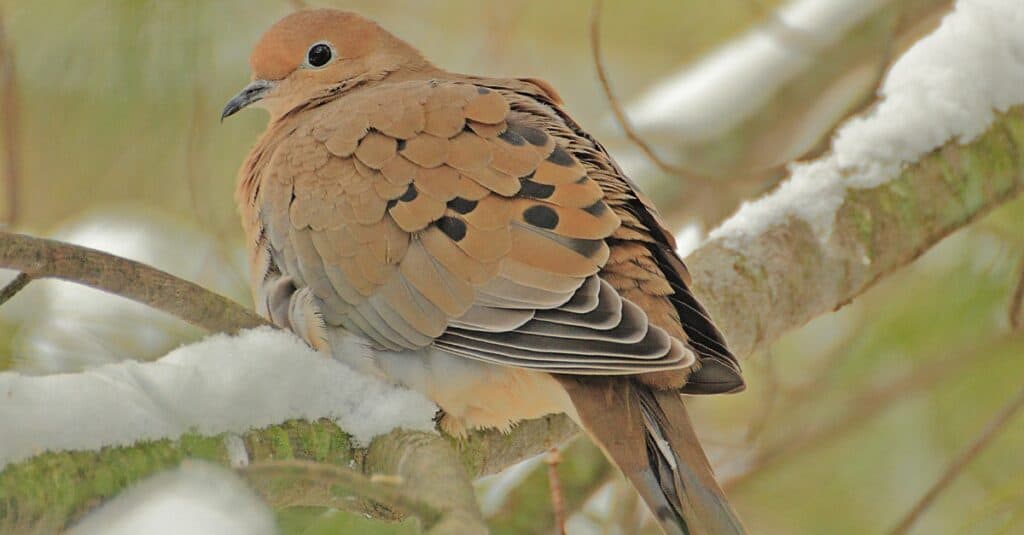
The
Mourning dove
mates for life.
©iStock.com/gregvandeleest
The Mourning Dove is another ordinary bird in North America. Its claim to fame might have the extinct passenger pigeon as its common ancestor. Yet, there is nothing distinctive about this medium-sized bird and its brownish-gray feathers. Their eating habits and locations are as prosaic as all other birds, except that they mate for life and co-parent new babies. Plus, it does have that characteristic and calming cooing sound most people recognize.
Fun Fact: Mourning Doves have the skill to drink water by sucking it up instead of scooping it up like most birds.
House Finch
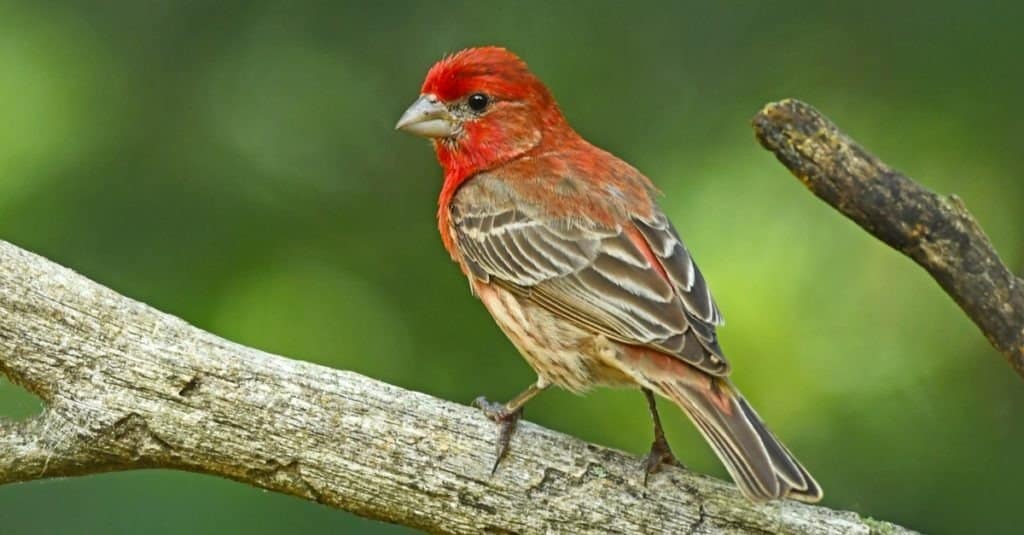
Found in winter landscapes but also American deserts.
©Brian A Wolf/Shutterstock.com
The House Finch is a small songbird with red feathers on its head and breast, characterized by their reasonably large beaks and long, flat heads. They live in fields, meadows, and urban areas. They share the feeding and living habits of most other birds, except they can be commonly found in the desert. This bird was originally found only in the western United States, but now you can find them across the country (including Wisconsin in the Winter).
Fun Fact: The House Finch possesses an almost superpower ability to see ultraviolet light, which helps them locate food and identify potential mates.
Purple Finch

Once popular as caged birds in the early 20th century.
©Steve Byland/Shutterstock.com
This cousin to the House Finch can be recognized by its raspberry-red and purple feathers on its head and breast. The Purple Finch doesn’t stand apart for habitats or diet. Although, they are known for employing their beaks to remove the seeds from pine cones (they do love black oil sunflower seeds). Like the Mourning Dove, they are monogamous.
Fun Fact: Purple Finches are sometimes referred to as “Hollywood Finches” because of being popular as caged birds in the early 20th century.
Pine Siskin
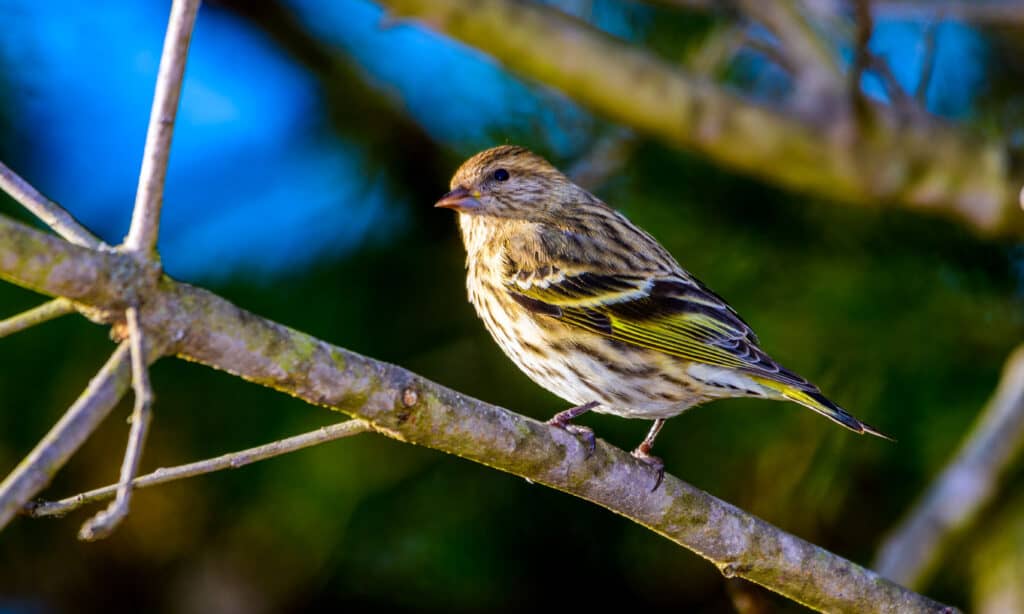
The pine siskin prefers coniferous forests and its abundance of pinecone seeds.
©Jeff W. Jarrett/Shutterstock.com
The Pine Siskin is a small bird with brown and yellow feathers, creating a lovely, streaked pattern on its wings. Their territory includes woodlands and suburban areas – but they favor coniferous forests. Outside of insects, the Pine Skin enjoys small seeds from thistle plants and trees that include hemlock, spruce, alder, and birch. Additionally, Pine Siskins have a unique habit of using their beaks to pry open the scales of pinecones to extract the seeds. Strangely, part of their diet can include mineral deposits from road salt, ashes, and fresh cement.
Fun Fact: Pine Siskins double as scavengers, taking fragments of larger seeds from larger birds.
Common Redpoll
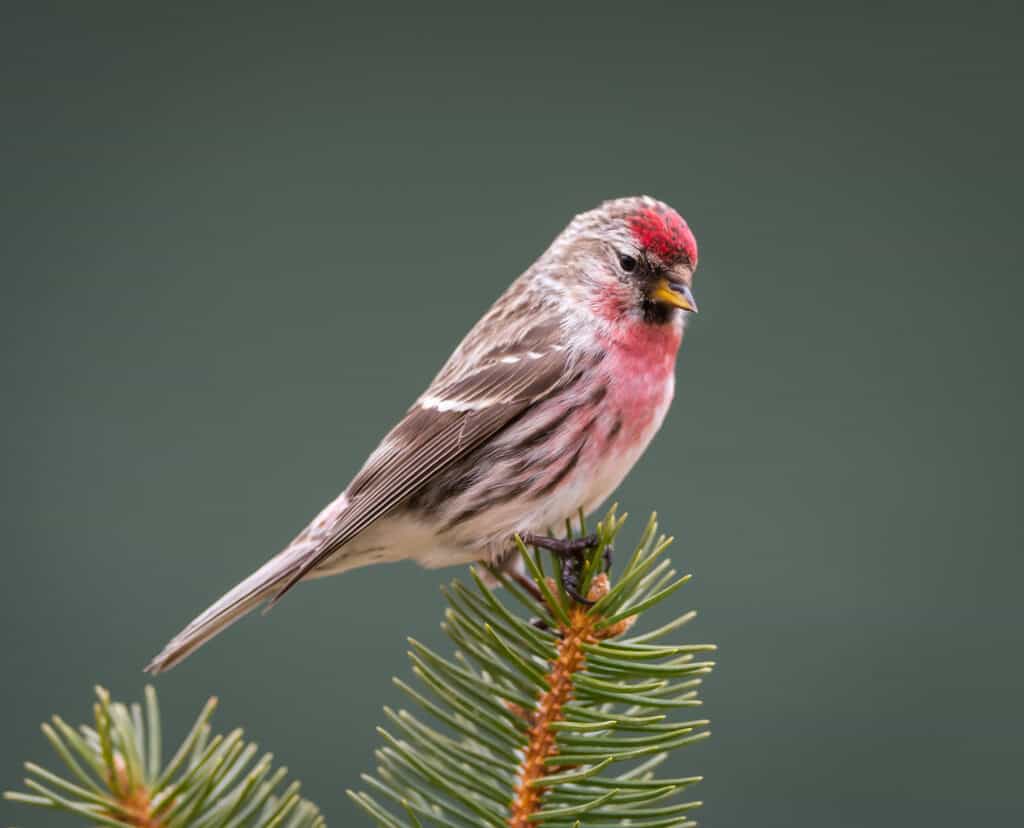
The Common Redpoll works part-time as a scavenger.
©FotoRequest/Shutterstock.com
The Common Redpoll is famous for its red cap on its forehead and a pair of white wing bars on its wings. The bird prospers in various sub-arctic habitats. How do they thrive in brutal climates? By creating snow tunnels for shelter and able to store alder and birch seeds in a throat pouch. They keep busy as these avians can consume up to 42 percent of their body mass every day!
Fun Fact: Redpolls often hang upside down from small branches while they are feeding.
Barred Owl

Does the
Barred owl
say, “Who cooks for you?
©Jim Cumming/Shutterstock.com
The Barred Owl possesses brown and white feathers and is famous for its hoot, which many folklorically translate to “Who cooks for you?” This medium-sized bird makes its home in woodlands and forests and is a carnivorous animal that eats small mammals, birds, and insects. Their call may be famous, but their hunting is infamous, specifically their habit of using their wings to create a canopy over their prey, which muffles the sound of their deadly attack.
Fun Fact: It’s not a myth: the Barred Owl can turn its head 270 degrees due to having 14 neck vertebrae, and their night vision and hearing are remarkable.
Snowy Owl

The
Snowy Owl
flies silently due to its special feathers.
©Carol Gray/iStock via Getty Images
The Snowy Owl is a large bird, and shocking no one because of its name owns white feathers (accentuating its haunting yellow eyes). The winter weather of Wisconsin is perfect for this avian, and they also enjoy icy tundra and open fields or grasslands. Like its Barred Owl cousin, they feed on smaller animals – although they do eat their prey whole just before they hear them moving under snow while flying with extremely soft feathers that make their flight silent.
Fun Fact: Perhaps shattering a myth, the Snowy Owls are an owl that is active during the day.
Red-Tailed Hawk
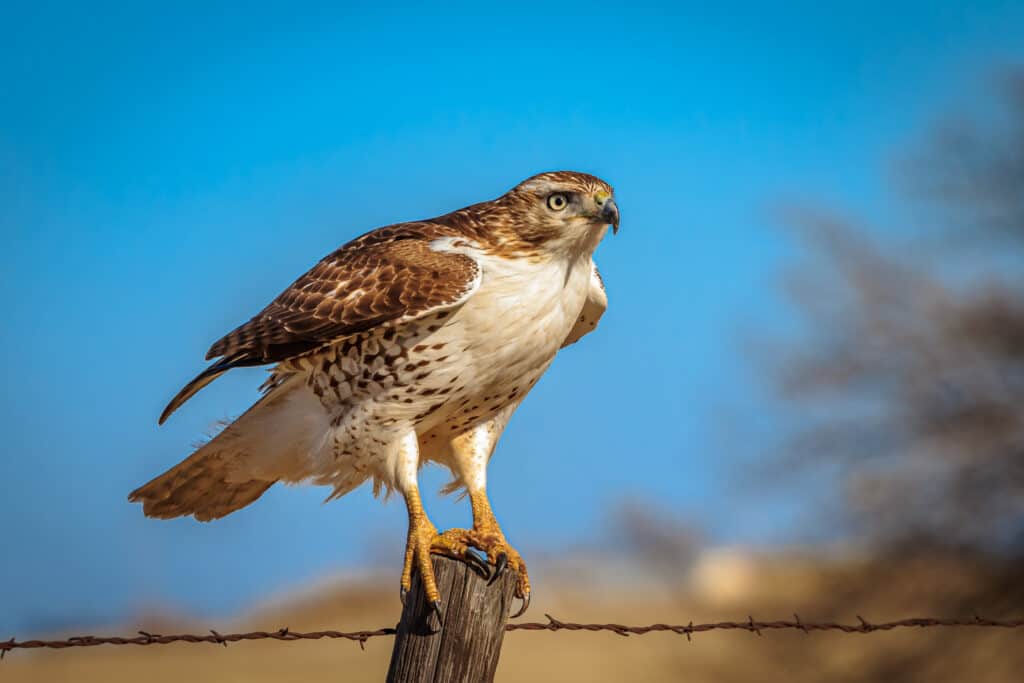
The Red-tailed hawk can reach incredible speeds when diving for prey.
©Richard G Smith/Shutterstock.com
The Red-tailed Hawk is a commanding bird of prey, recognized by its brown feathers and distinct red tail. They live in woodlands and open fields, hunting for game such as small mammals, reptiles, fish, and insects. Like owls, they possess keen sight but are true speedsters able to reach 120 mph when diving for a kill. They mate for life and often appeared in paintings on the arms of individuals to indicate nobility.
Fun Fact: Red-tailed Hawks are the most common hawk in North America.
Common Loon
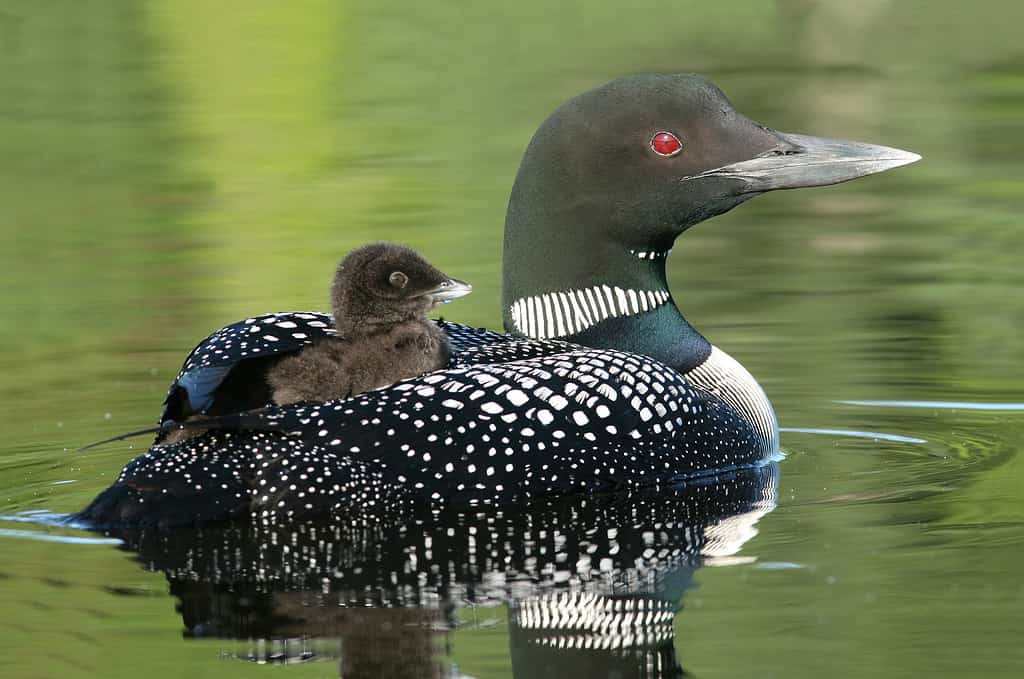
The
Common Loon
is an expert swimmer but can barely move on land.
©BRIAN LASENBY/iStock via Getty Images
It’s time to get to a waterbird finally. This one has no problem with the frigid winter rivers and lakes of Wisconsin and the rest of the north. The Common Loon possesses black and white feathers and falls in the category of a large-sized bird. They live near lakes and rivers. Although, they migrate to the coastal waters of the Great Lakes during the colder days of Winter. They feed primarily on fish, though they also eat crayfish and shrimp. Oddly, they eat their food underwater instead of bringing it to the surface for mealtime.
Fun Fact: Although skilled swimmers, the Common Loon cannot walk because their legs are far to the rear of their bodies. They have to drag themselves on their chest while on land.
Bald Eagle
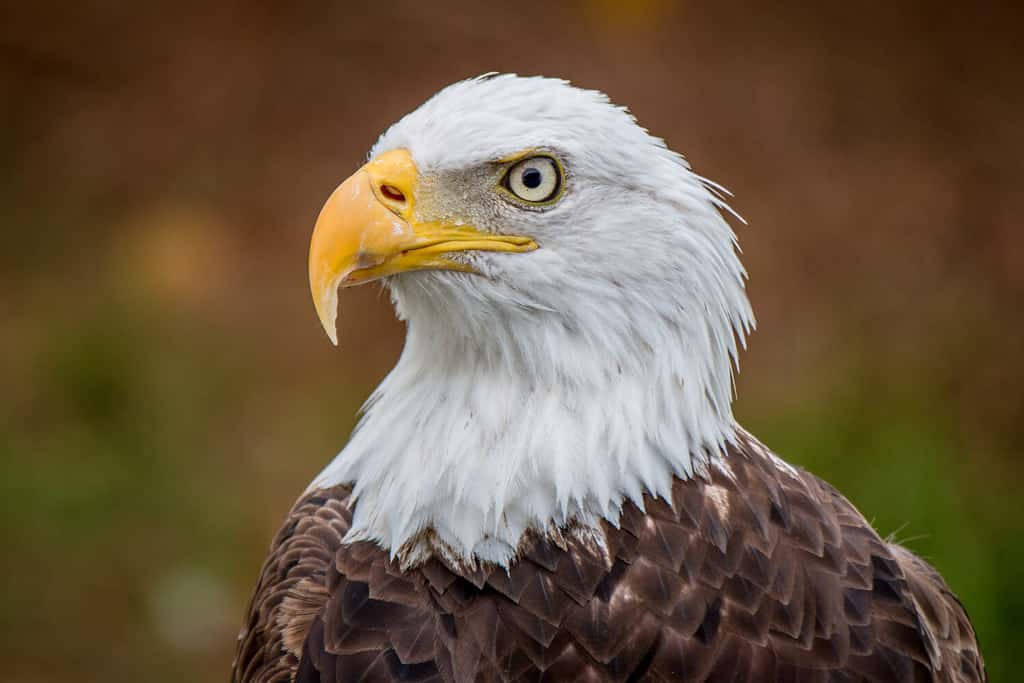
The Bald Eagle is the national bird symbol of the US.
©Kevin Tubbergen/Shutterstock.com
The last bird is far from the least; nothing is more regal than spotting a Bald Eagle in the Winter Wisconsin skies. This bird of prey is one of the largest raptors in the world, as well as for its legendary brown feathers and distinctive white head and tail. They frequent near bodies of water like lakes and rivers and feed on a variety of smaller mammals and fish. It can soar over 10,000 feet with its imposing wingspan of up to 8 feet while being able to spot a fish a mile away.
Fun Fact: Bald Eagles are the national bird and symbol of the US, although ironically, their biggest extinction threat comes from Americans (even in Wisconsin).
| Wisconsin Winter Bird | Scientific Name | Fun Fact |
|---|---|---|
| Black-capped Chickadee | Poecile atricapillus | Can remember the location of thousands of food caches. |
| Dark-eyed Junco | Junco hyemalis | Called “snowbirds” as they can even live in the Artic regions. |
| American Goldfinch | Spinus tristis | State bird of New Jersey, Iowa, and Washington |
| Northern Cardinal | Cardinalis cardinalis | Called “snowbirds” as they can even live in the Arctic regions. |
| Downy Woodpecker | Picoides pubescens | Smallest woodpecker in North America |
| White-Breasted Nuthatch | Sitta carolinensis | Easily walk headfirst down trees |
| American Crow | Corvus brachyrhynchos | Smallest woodpecker in America |
| Blue Jay | Cyanocitta cristata | Mimics sounds to keep other birds away from its territory |
| Mourning Dove | Zenaida macroura | Drink water by sucking it up instead of scooping it up like most birds |
| House Finch | Haemorhous mexicanus | Sees ultraviolet light, helping it locate food and mates in the dark |
| Purple Finch | Haemorhous purpureus | Aggressive and will even attack its reflection |
| Pine Siskin | Spinus pinus | Scavengers that take fragments of seeds from larger birds. |
| Common Redpoll | Acanthis flammea | Hang upside down from small branches while they are feeding |
| Barred Owl | Strix varia | Remarkable night vision and hearing |
| Snowy Owl | Bubo scandiacus | Rare owl that hunts during the day |
| Red-Tailed Hawk | Buteo jamaicensis | Known as “Hollywood Finches” because of their popularity as caged birds in the early 20th century |
| Common Loon | Gavia immer | The most common hawk in North America |
| Bald Eagle | Haliaeetus leucocephalus | Cannot walk on land due to their legs being far to the rear of their bodies |
Thank you for reading! Have some feedback for us? Contact the AZ Animals editorial team.

